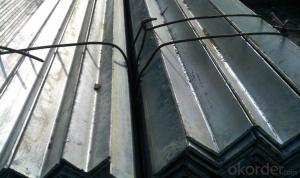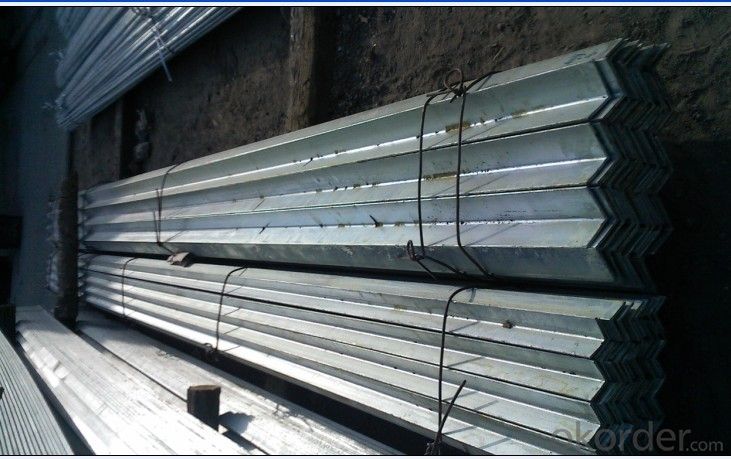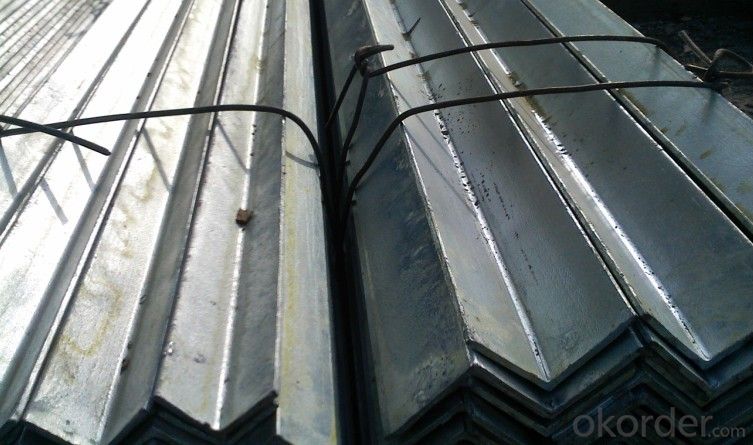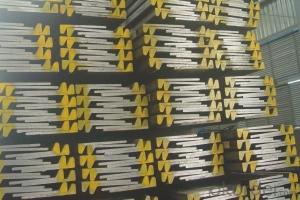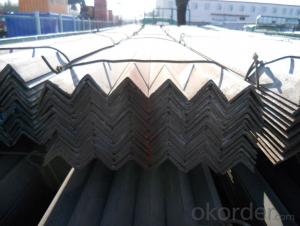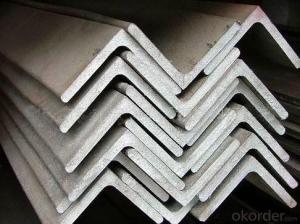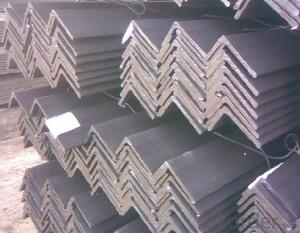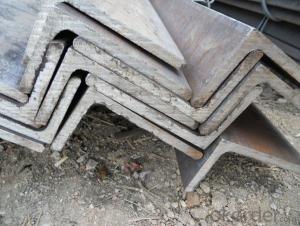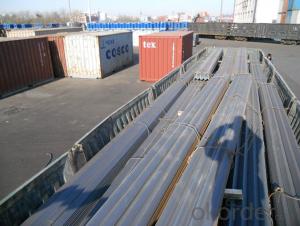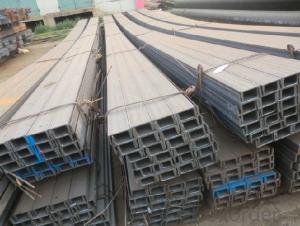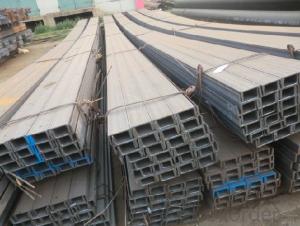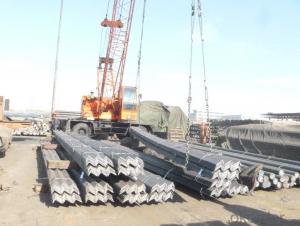hot angleand gb
- Loading Port:
- China Main Port
- Payment Terms:
- TT OR LC
- Min Order Qty:
- -
- Supply Capability:
- -
OKorder Service Pledge
OKorder Financial Service
You Might Also Like
Product Description:
Specifications of Angle Steel
1. Invoicing on theoretical weight or actual weight as customer request
2. Length: 6m, 9m, 12m as following table
3. Sizes
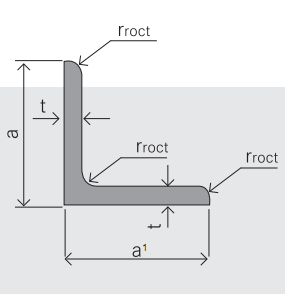
Sizes: 25mm-250mm | ||
a*t | ||
25*2.5-4.0 | 70*6.0-9.0 | 130*9.0-15 |
30*2.5-6.6 | 75*6.0-9.0 | 140*10-14 |
36*3.0-5.0 | 80*5.0-10 | 150*10-20 |
38*2.3-6.0 | 90*7.0-10 | 160*10-16 |
40*3.0-5.0 | 100*6.0-12 | 175*12-15 |
45*4.0-6.0 | 110*8.0-10 | 180*12-18 |
50*4.0-6.0 | 120*6.0-15 | 200*14-25 |
60*4.0-8.0 | 125*8.0-14 | 250*25 |
5. Payment terms:
1).100% irrevocable L/C at sight.
2).30% T/T prepaid and the balance against the copy of B/L.
3).30% T/T prepaid and the balance against L/C
6.Material details:
Alloy No | Grade | Element (%) | | ||||
C | Mn | S | P | Si | | ||
| | |||||||
|
|
|
|
|
|
| |
Q235 | B | 0.12—0.20 | 0.3—0.7 | ≤0.045 | ≤0.045 | ≤0.3 | |
|
|
|
|
|
|
| |
Alloy No | Grade | Yielding strength point( Mpa) | | ||||
Thickness (mm) | | ||||||
≤16 | >16--40 | >40--60 | >60--100 | | |||
≥ | | ||||||
|
|
|
|
|
| | |
Q235 | B | 235 | 225 | 215 | 205 | | |
Alloy No | Grade | Tensile strength (Mpa) | Elongation after fracture (%) | | |||
Thickness (mm) | | ||||||
| ≤16 | >16--40 | >40--60 | >60--100 | | ||
≥ | | ||||||
|
|
|
|
|
|
| |
Q235 | B | 375--500 | 26 | 25 | 24 | 23 | |
Usage & Applications of Angle Steel
According to the needs of different structures, Angle can compose to different force support component, and also can be the connections between components. It is widely used in various building structures and engineering structures such as roof beams, bridges, transmission towers, hoisting machinery and transport machinery, ships, industrial furnaces, reaction tower, container frame and warehouse etc.
Packaging & Delivery of Angle Steel
1. Packing: it is nude packed in bundles by steel wire rod
2. Bundle weight: not more than 3.5MT for bulk vessel; less than 3 MT for container load
3. Marks:
Color marking: There will be color marking on both end of the bundle for the cargo delivered by bulk vessel. That makes it easily to distinguish at the destination port.
Tag mark: there will be tag mark tied up on the bundles. The information usually including supplier logo and name, product name, made in China, shipping marks and other information request by the customer.
- Q: How do you prevent warping of steel angles during fabrication?
- To prevent warping of steel angles during fabrication, several measures can be taken. Firstly, it is essential to ensure proper storage and handling of the angles to avoid any bending or twisting. During welding or heating processes, it is crucial to control the temperature and heat distribution evenly to prevent localized expansion or contraction that may lead to warping. Additionally, using proper clamping or fixturing techniques can help maintain the desired shape and prevent warping. Lastly, post-fabrication processes like stress relieving or annealing can be employed to release any residual stresses in the angles and minimize the risk of warping.
- Q: What is the weight of a standard steel angle?
- The weight of a standard steel angle can vary depending on its size and dimensions.
- Q: Are steel angles resistant to extreme weather conditions?
- Known for their durability and strength, steel angles are highly resistant to extreme weather conditions. Typically made from hot-rolled steel, which possesses excellent weathering properties, these angles exhibit a high tensile strength and can endure harsh conditions like heavy rainfall, high winds, and extreme temperatures. Additionally, steel angles possess corrosion-resistant properties, enabling them to withstand exposure to moisture and humidity without rusting or deteriorating. This characteristic makes them ideal for outdoor applications where they may encounter rain, snow, or other environmental factors. Moreover, steel angles offer exceptional stability and maintain their shape and structural integrity even under the harshest weather conditions. They are specifically designed to provide support and stability to structures, rendering them perfect for use in buildings, bridges, and other infrastructure projects that need to withstand hurricanes, earthquakes, or other severe weather events. In summary, steel angles are an exceptional choice for applications that demand resistance to extreme weather conditions. Their strength, durability, and corrosion resistance make them a dependable and long-lasting alternative for outdoor structures.
- Q: Can steel angles be used in railway or transportation infrastructure?
- Steel angles have the potential to be utilized in railway or transportation infrastructure. They are frequently employed in the building of bridges, tunnels, and railway tracks. These infrastructure components rely on steel angles for structural support and stability. The reputation of steel angles stems from their strength, durability, and versatility. They can be effortlessly fabricated and installed, which contributes to their popularity in transportation projects. Additionally, steel angles possess the ability to endure substantial loads and adverse weather conditions, rendering them suitable for railway and transportation purposes where safety and reliability are of utmost importance. In summary, steel angles offer a dependable and cost-effective solution for railway and transportation infrastructure needs.
- Q: How do you specify steel angles in drawings?
- In order to specify steel angles in drawings, several key parameters need to be specified. Firstly, the angle size needs to be clearly indicated, usually by providing the leg lengths or the dimensions of the equal sides. For example, a 3" x 3" x 1/4" angle would have legs measuring 3 inches each and a thickness of 1/4 inch. Next, the type of angle needs to be indicated, such as L-shaped or unequal angles. This information is important as it helps determine the appropriate steel angle to be used for a specific application. Additionally, the material grade of the steel angle should be specified. Steel angles are available in various grades, which determine the strength and durability of the angle. Common grades include A36, A572, and A588, among others. The grade is typically specified to ensure the angle meets the required structural or mechanical properties. The length of the steel angle is another important parameter that needs to be stated in the drawing. Whether it is a fixed length or a specific range, this information enables accurate fabrication and installation. Finally, any additional requirements or specifications, such as surface finish, tolerance, or any specific treatments or coatings, should also be clearly indicated in the drawing to ensure the steel angle is manufactured and installed according to the desired specifications. By providing these parameters in the drawings, engineers, fabricators, and contractors can easily identify and accurately procure the required steel angles for construction or manufacturing purposes.
- Q: What are the different types of steel angles used in manufacturing industries?
- In manufacturing industries, there is a wide variety of steel angles utilized for different purposes. These angles possess unique characteristics that make them suitable for specific applications. 1. Unequal Leg Angles, also known as L-shaped angles, feature one longer leg and one shorter leg. They find common usage in construction and structural engineering due to their versatility. These angles offer exceptional strength and stability, making them ideal for supporting heavy loads and establishing structural connections. 2. Equal Leg Angles, also known as L-shaped angles, have both legs of equal length. They are extensively employed in manufacturing industries for diverse purposes, including bracing, framing, and supporting structures. These angles exhibit good resistance to bending and provide stable connections in various applications. 3. Stainless Steel Angles are crafted from a corrosion-resistant steel alloy, primarily comprising chromium. They possess remarkable durability, resistance to rust, and excellent strength properties. Stainless steel angles find widespread use in industries such as food processing, chemical processing, and marine manufacturing, where corrosion resistance is of utmost importance. 4. Galvanized Steel Angles are coated with a layer of zinc to safeguard them against corrosion and rust. This zinc coating ensures exceptional durability and longevity, rendering galvanized steel angles suitable for outdoor and exposed applications. They are commonly employed in industries like construction, agriculture, and transportation. 5. Rolled Steel Angles are manufactured by rolling a steel plate or sheet into the desired shape. These angles offer an excellent strength-to-weight ratio and can be produced in varied sizes and thicknesses. Rolled steel angles find extensive usage in construction, machinery, and fabrication industries for structural support and framing applications. 6. Slotted Steel Angles possess holes or slots along their length, allowing for flexibility in terms of fastening methods. They are frequently employed in shelving systems, racking, and storage solutions as they allow for easy adjustment and customization. Slotted steel angles offer versatility and convenience in manufacturing industries where quick assembly and reconfiguration are required. In summary, the assortment of steel angles utilized in manufacturing industries provides a range of properties and advantages. The choice of angle depends on the specific application, requirements for strength, corrosion resistance, and other factors that guarantee optimal performance and durability in the given application.
- Q: How do you prevent steel angles from bending under load?
- One way to prevent steel angles from bending under load is by using thicker and stronger materials that can withstand higher levels of stress and strain. Additionally, reinforcing the angles with stiffeners or braces can help distribute the load more evenly, reducing the chances of bending. Proper design and engineering, considering factors such as the anticipated load, the angle's dimensions, and its support structure, are crucial in ensuring its resistance to bending.
- Q: Can steel angles be used for shelving units?
- Absolutely! Shelving units can indeed utilize steel angles. These angles are widely employed in construction and industrial settings owing to their impressive robustness and endurance. They offer exceptional structural reinforcement and can effortlessly bear substantial loads, rendering them perfect for shelving units that necessitate the support of considerable weight. Moreover, steel angles are incredibly adaptable and can be effortlessly tailored to suit diverse shelving designs and setups. Whether it be for domestic, corporate, or commercial purposes, steel angles are a dependable option for crafting resilient and enduring shelving units.
- Q: Can steel angles support heavy loads?
- Steel angles have the ability to bear heavy loads. These L-shaped metal bars, known as steel angles, are frequently employed in construction and engineering for their sturdy and long-lasting nature. The unique design of steel angles enables them to evenly distribute weight, rendering them capable of enduring substantial loads. They are commonly utilized as structural supports and reinforcement in a variety of structures, including buildings, bridges, and machinery. Furthermore, engineers can tailor the dimensions and thickness of steel angles to meet precise load demands, making them a dependable option for supporting heavy loads.
- Q: How do you determine the required number of steel angles for a project?
- Determining the required number of steel angles for a project involves considering several factors. Firstly, it is important to understand the design and specifications of the project. This includes the structural requirements, load-bearing capacities, and any specific angles or dimensions that need to be incorporated. Secondly, the dimensions of the steel angles need to be determined based on the intended use and structural requirements. This includes considering the length, width, and thickness of the angles that would be suitable for the project. Once the dimensions are established, the next step is to calculate the number of angles required. This can be done by carefully measuring and estimating the lengths of the steel angles needed in each area of the project. It is important to consider any potential waste or additional cuts that may be required during the installation process. In addition, it is recommended to consult with structural engineers or professionals experienced in steel fabrication to ensure accurate calculations and to confirm that the selected steel angles meet the necessary safety standards and building codes. Ultimately, determining the required number of steel angles for a project requires a combination of careful planning, accurate measurements, and professional expertise to ensure the project is structurally sound and meets all necessary requirements.
Send your message to us
hot angleand gb
- Loading Port:
- China Main Port
- Payment Terms:
- TT OR LC
- Min Order Qty:
- -
- Supply Capability:
- -
OKorder Service Pledge
OKorder Financial Service
Similar products
Hot products
Hot Searches
Related keywords
